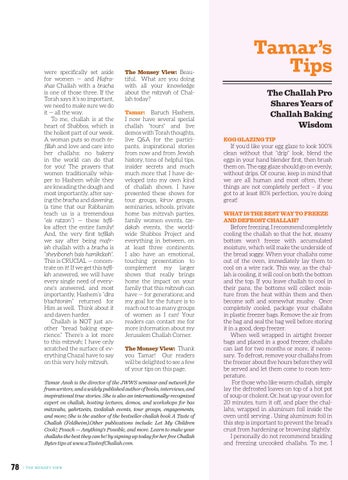were specifically set aside for women — and Hafrashas Challah with a bracha is one of those three. If the Torah says it’s so important, we need to make sure we do it — all the way. To me, challah is at the heart of Shabbos, which is the holiest part of our week. A woman puts so much tefillah and love and care into her challahs; no bakery in the world can do that for you! The prayers that women traditionally whisper to Hashem while they are kneading the dough and most importantly, after saying the bracha and davening, (a time that our Rabbanim teach us is a tremendous “eis ratzon”) — these tefillos affect the entire family! And, the very first tefillah we say after being mafrish challah with a bracha is “sheyiboneh bais hamikdash”. This is CRUCIAL — concentrate on it! If we get this tefillah answered, we will have every single need of everyone’s answered, and most importantly, Hashem’s “dira b’tachtonim” returned for Him as well. Think about it and daven harder. Challah is NOT just another “bread baking experience.” There’s a lot more to this mitzvah; I have only scratched the surface of everything Chazal have to say on this very holy mitzvah.
The Monsey View: Beautiful. What are you doing with all your knowledge about the mitzvah of Challah today? Tamar: Baruch Hashem, I now have several special challah “tours” and live demos with Torah thoughts, live Q&A for the participants, inspirational stories from now and from Jewish history, tons of helpful tips, insider secrets and much much more that I have developed into my own kind of challah shows. I have presented these shows for tour groups, kiruv groups, seminaries, schools, private home bas mitzvah parties, family women events, tzedakah events, the worldwide Shabbos Project and everything in between, on at least three continents. I also have an emotional, touching presentation to complement my larger shows that really brings home the impact on your family that this mitzvah can have — for generations; and my goal for the future is to reach out to as many groups of women as I can! Your readers can contact me for more information about my Jerusalem Challah Corner. The Monsey View: Thank you Tamar! Our readers will be delighted to see a few of your tips on this page.
Tamar Ansh is the director of the JWWS seminar and network for frum writers, and a widely published author of books, interviews, and inspirational true stories. She is also an internationally-recognized expert on challah, hosting lectures, demos, and workshops for bas mitzvahs, yahrtzeits, tzedakah events, tour groups, engagements, and more; She is the author of the bestseller challah book A Taste of Challah (Feldheim).Other publications include: Let My Children Cook!; Pesach — Anything’s Possible, and more. Learn to make your challahs the best they can be! by signing up today for her free Challah Bytes tips at www.aTasteofChallah.com.
78
/ T HE MONS E Y V IE W
Tamar’s Tips The Challah Pro Shares Years of Challah Baking Wisdom EGG GLAZING TIP If you’d like your egg glaze to look 100% clean without that “drip” look, blend the eggs in your hand blender first, then brush them on. The egg glaze should go on evenly, without drips. Of course, keep in mind that we are all human and most often, these things are not completely perfect – if you got to at least 80% perfection, you’re doing great! WHAT IS THE BEST WAY TO FREEZE AND DEFROST CHALLAH? Before freezing, I recommend completely cooling the challah so that the hot, steamy bottom won’t freeze with accumulated moisture, which will make the underside of the bread soggy. When your challahs come out of the oven, immediately lay them to cool on a wire rack. This way, as the challah is cooling, it will cool on both the bottom and the top. If you leave challah to cool in their pans, the bottoms will collect moisture from the heat within them and then become soft and somewhat mushy. Once completely cooled, package your challahs in plastic freezer bags. Remove the air from the bag and seal the bag well before storing it in a good, deep freezer. When well wrapped in airtight freezer bags and placed in a good freezer, challahs can last for two months or more, if necessary. To defrost, remove your challahs from the freezer about five hours before they will be served and let them come to room temperature. For those who like warm challah, simply lay the defrosted loaves on top of a hot pot of soup or cholent. Or, heat up your oven for 20 minutes, turn it off, and place the challahs, wrapped in aluminum foil inside the oven until serving . Using aluminum foil in this step is important to prevent the bread’s crust from hardening or browning slightly. I personally do not recommend braiding and freezing uncooked challahs. To me, I
